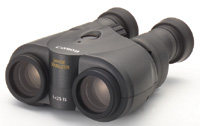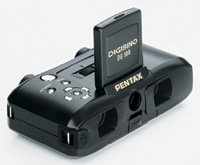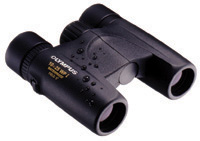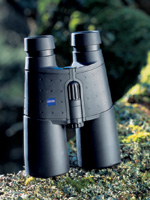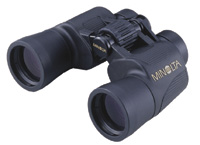What Is New In Binoculars For 2003 And 2004
Trends In Getting Up Close And Personal
Whenever outdoor photographers discuss their favorite gear, one significant item is frequently overlooked--binoculars. Available in many different styles and powers, binoculars are invaluable for scanning or scouting an area and also for searching out potential subjects. Especially in bird and wildlife photography, binoculars can increase your odds of a successful outing. Naturally, binoculars are useful for viewing other types of subjects, too: butterflies, stars, boats, sports and motor racing action, and so on. For anyone who has tried them, binoculars soon become a valuable accessory, as I first discovered many years ago. |
|||
If you don't own binoculars yet--or if you're in the market for a pair with improved design--read on for our brief buyer's guide to the latest in double-barreled optics. Because the new models vary considerably in price, size, and features, you should be able to find exactly what you need. And if you're not fully up-to-date on binocular features, review the information and recommendations provided in our "Buying Points." Rugged And Weatherproof |
|||
If you're on a really
tight budget, but still want waterproof binoculars, check out the five
new Celestron Outland models (8x25 to 12x50; $49-$99) with BaK-4 roof
prisms and multi-coating or the Oceana 7x50 CF porro prism model ($99)
that's also nitrogen filled. Minolta's Classic Sport series
is also affordable ($115-$145) for nitrogen filled 8x42WP, 10x50WP, and
12x50WP models (from 27-31 oz) with BaK-4 porro prisms, |
|||
Moving up a notch in price, you'll find the new Pentax 8x42 and 10x42 DCF HR II series ($280 and $300, respectively) with waterproof and fogproof construction in a body made of fiber-reinforced polycarbonate with a rubber housing. The new premium-grade Pentax DCF SP (roof prism) line consists of four waterproof nitrogen filled binoculars encased in a magnesium-alloy body: the 8x43, 10x43, 10x50, and 12.5x50 models ($599-$799). Features include inner-focus, aspherical eyepiece lenses, high-resolution phase-coated roof prisms, and multi-coated optical elements. |
|||
If those models are above your budget, check out the redesigned Nikon Monarch ATB 8x42 or 10x42 ($290 and $329, respectively; 21 oz). These binoculars are waterproof and fogproof with phase-corrected roof prisms for high edge-to-edge sharpness. For maximum light transmission, they feature a wide objective lens and exit pupil plus lenses with full multi-coating. Both are also shockproof, thanks to a durable metal-alloy housing while the rubber armor provides a firm grip, wet or dry. Wide Angle Design |
|||
Zooming Feature |
|||
You can find many porro prism
zoom models that tip the scales at 13 oz or less and cost around $140.
These include the Minolta Activa Compact Zoom 8-22x27 FM, with BaK-4 prisms
and an aspherical element, and two Nikon models: the Eagle View Zoom II
8-24x25, with BaK-4 prisms and multi-coated optics, and the Travelite
V Zoom 8-24x25 ($159) with the same features plus aspherical eyepiece
lenses for a flat field of view and strain-free viewing. If you're
considering zoom binoculars, review the specifications of several models
and try them while shopping. Select the one that provides the best viewing
comfort as well as acceptable brightness at various zoom settings. |
|||
Internal Stabilizer
|
|||
Close Focusing Maximum Light Transmission |
|||
Digital Imaging Buy The Right Binoculars
Binocular Buying Points Manufacturers/Distributors
Canon U.S.A., Inc. Carl Zeiss Sports Optics Celestron Eagle Optics Leica Camera Inc. (Minox) Minolta Corporation Night Owl Optics Nikon Inc. Olympus America Inc. Pentax U.S.A. Inc. Pioneer Research (Steiner) Swift Instruments, Inc. |



